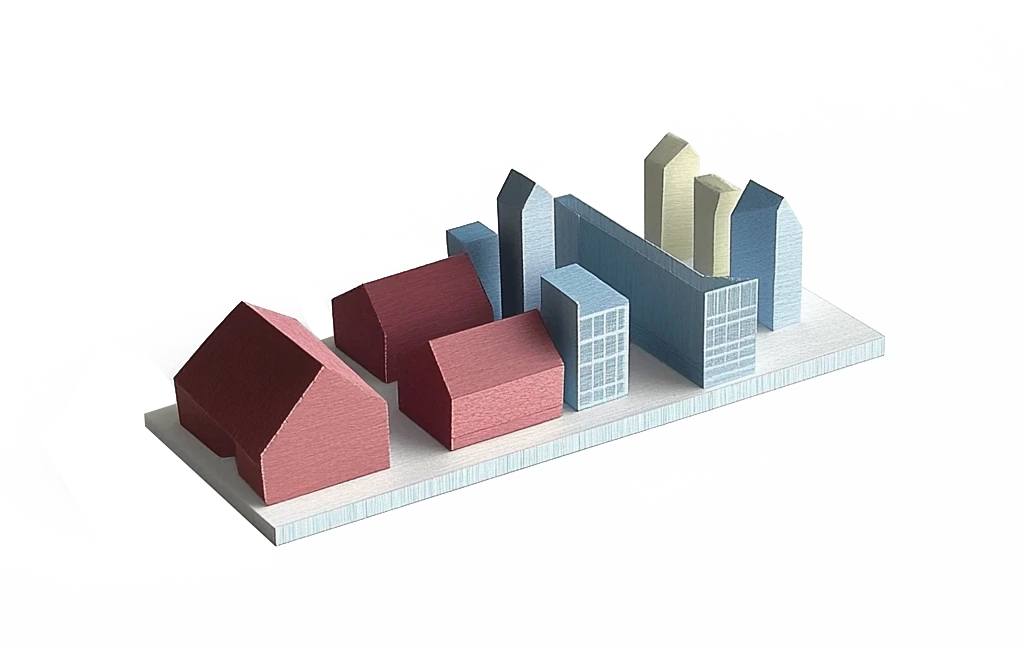Generative AI and rendering - why artificial intelligence can't replace a visualization studio yet
Generative artificial intelligence is making a lot of noise in the field of architectural visualization. It promises to revolutionize the way we conceive and represent spaces, from concept ideation to generating formal variations in just seconds.
There's no doubt that AI can significantly accelerate the early creative phases of a project, offering rapid and often unexpected visual suggestions. But when moving from inspiration to realization, when reliability, deep understanding of design requirements and that technical precision necessary to actually build are needed, things change.
The difference between a suggestive image generated by an algorithm and a faithful representation of a feasible project - one that reflects not only the designers' ideas but also the care for technical details - is substantial. And on this gap, AI still has a long way to go.
AI as a creative exploration tool
DEAL, as a reality oriented towards digital and innovation, looks with interest at the potential of generative artificial intelligence. Research and experimentation are always active, especially to understand how this technology can integrate into existing processes.
AI excels in the initial phases of the design process. It can rapidly generate visual concepts, proposing different aesthetic and functional variants in very short times. This accelerates brainstorming and allows presenting preliminary stylistic options to clients more effectively. It facilitates the creation of scenarios and atmospheres, generating evocative images from simple descriptions or basic sketches.
Post-production applications are also interesting: targeted modifications like changing the color of specific elements, adding people to scenes, generative expansions of image parts. All targeted interventions within a broader context developed with traditional methods.
One of the most promising applications is the ability to animate static renderings, transforming them into short animations or walkthroughs that simulate paths through spaces. This adds dynamism to visual presentation, making the experience more immersive even without creating a complete VR model. You can see concrete examples of how AI can animate images in some of the media attached to this journal article or by exploring our Works page.
Video animation of a render previously produced by DEAL Studio - Mestre Commercial Centre, Mestre, 2021
These capabilities potentially allow dedicating more time to innovation and design strategy. However, AI's role stops where the need for precision and technical applicability begins - essential elements for the implementation phase.
Reliability and "design accuracy", the limits of AI
Architecture is a discipline that combines creativity, aesthetic sensitivity and deep understanding of human needs. Even if AI can amplify the designer's capabilities, it cannot replace the architect's overall vision, contextual sensitivity and critical thinking.
Current AI tools often overlook complex but critical factors: budget constraints, regulatory compliance, site-specific construction limitations, physical properties of materials. Managing contextual complexity and producing precise results for textures and details remain significant challenges.
Despite their generative power, AI-produced renders seem to lack that architectural "common sense", the aesthetic intuition and critical judgment capacity that characterize the experienced professional. AI can be a powerful amplification and exploration tool, but the professional remains the "conductor" who infuses meaning, context and authenticity into the final project.
This is where the fundamental difference emerges between what generative AI can produce and what an experienced professional guarantees. Among all the various nuances that come to mind, there are two that more than others have an actual gap still to be filled (mainly speaking about renders).
- Deep understanding of context: An algorithm, however advanced, does not fully interpret the nuances of a landscape, regulatory or cultural context, the specificities of a site, the structural or systems implications, or the unexpressed needs of a client. It lacks understanding of "what" must be built and "how" to realize it safely and functionally.
- Delivering design accuracy: Fidelity and consistency between different disciplines (architectural, structural, MEP) are essential. A professional renderer doesn't just produce "beautiful images", but accurate representations derived from precise BIM models, detailed laser scanner surveys and careful technical evaluation. Consistency and technical reliability remain human prerogatives.
AI as a tool, not as a substitute
Generative AI deserves attention as a valuable ally for accelerating the exploratory and creative phases of design. From initial visualization to idea refinement, it can enrich the workflow allowing greater experimentation. And surely the future will open further paths that perhaps will make this article obsolete or that will definitively change the game once again.

However, reliability, deep understanding of design dynamics and the ability to guarantee the accuracy necessary to transform an idea into concrete work remain firmly in the hands of the professional. The renderer, the computational designer, the architect: it's their critical competence and expert eye that make the difference, ensuring that fidelity to the executive project that no algorithm can yet replicate.
The most promising future for the sector doesn't lie in replacement, but in intelligent synergy. AI as a powerful accelerator of ideas and the professional as irreplaceable guarantor of precision, feasibility and final quality. It's in this collaboration that true progress is found, not in simple technological shortcuts.
Explore more...